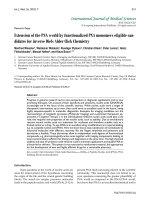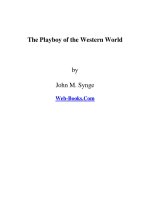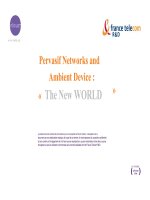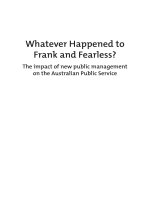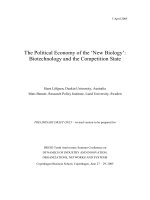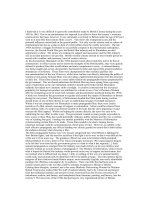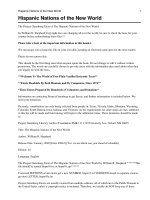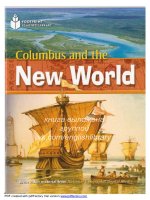christopher columbus explorer of the new world
Bạn đang xem bản rút gọn của tài liệu. Xem và tải ngay bản đầy đủ của tài liệu tại đây (11.74 MB, 46 trang )
PRE-PUBLICATION DATA
Format: PLCJ, 276 x 216 mm (10
7
⁄8 x 8
1
⁄2 in)
Extent: 48 pages
Full colour throughout
More than 70 photos and 50 illustrations
Approx. 15,000 words
Publication Date: Autumn 2001
Price: £9.99
ISBN: 0 7513 1388 2
C
OLUMB
U
S
C
H
RIST
O
P
H
ER
BE AN EYEWITNESS TO
CASTLE AT WAR
CHRISTOPHER COLUMBUS
Peter Chrisp
About the series
• Vivid storytelling brings
the past to life.
• Exciting eyewitness accounts
make you feel part of the action.
• Stunning photographs, pull-out
details, and exploded views help
you piece together the story.
C
H
RIST
O
P
H
ER
C
OLUMB
U
S
BE AN
EYEWITNESS TO
Explorer of the New World
Columbus’s
of
thrilling
voyages
exploration
Columbus’s
of
thrilling
voyages
exploration
C
HRISTOPHER
COLUMBUS
EXPLORER OF THE
NEW WORLD
The Pinta
The royal treasurer
begs Queen Isabella
of Spain to back
Columbus’s voyage.
Portuguese
traders
importing
slaves from
Africa
Columbus
lands at
San Salvador.
A Dorling Kindersley Book
Written by
PETER CHRISP
Illustrated by
PETER DENNIS
C
HRISTOPHER
COLUMBUS
EXPLORER OF THE
NEW WORLD
Contents
6
THE AGE OF
EXPLORATION
8
IN SEARCH OF THE INDIES
10
CHRISTOPHER
COLUMBUS
12
THE PLAN
14
THE QUEST FOR A ROYAL
SPONSOR
16
SHIPS AND CREW
18
THE FLEET SETS OFF
Dorling Kindersley
LONDON, NEW YORK, SYDNEY, DELHI, PARIS,
MUNICH, and JOHANNESBURG
Project Editor Steve Setford
Art Editor Peter Radcliffe
Senior Editor Marie Greenwood
Senior Art Editor Carole Oliver
Managing Art Editor Jacquie Gulliver
Publishing Manager Jayne Parsons
DTP Designer Nomazwe Madonko
Picture Researchers Amanda Russell, Pernilla Pearce,
and Marie Osborn
Jacket Designer Dean Price
Production Kate Oliver, Jenny Jacoby
Additional illustrations by David Ashby
First published in Great Britain in 2001 by
Dorling Kindersley Limited,
80 Strand, London WC2R ORL,
2 4 6 8 10 9 7 5 3 1
Copyright © 2001 Dorling Kindersley Ltd
All rights reserved. No part of this publication
may be reproduced, stored in a retrieval system,
or transmitted in any form or by any means,
electronic, mechanical, photocopying, recording,
or otherwise, without the prior
permission of the copyright owner.
A CIP catalogue record for this book is available
from the British Library.
ISBN 0 7513 1388 2
Reproduced by Colourscan, Singapore
Printed and bound by L.E.G.O., Italy
FFoorr LLiissaa
see our complete
catalogue at
WWW.dk.com
20
THE VOYAGE
24
THE MEN FROM THE SKY
26
SHIPWRECKED IN
HISPANIOLA
28
TRIUMPHANT
HOMECOMING
30
THE SPANISH
SETTLEMENT
32
COLUMBUS RETURNS
34
HORROR ON HISPANIOLA
36
TO THE MAINLAND
38
ANOTHER WORLD
40
ACROSS THE WILD
CARIBBEAN
42
STRANDED!
44
VOYAGES OF
EXPLORATION
46
CONQUISTADORES
48
INDEX
U
NTIL THE EARLY 1400S, Europeans knew
little about the wider world. But
everything changed in the 15th century,
when the kingdom of Portugal began
to send ships out on voyages of
exploration. Portuguese explorers
worked their way down the western
coast of Africa, establishing trading
posts as they went, and found a
route into the Indian Ocean.
World map by Henricus
Martellus, c.1490
The Age of
Exploration
This is the story of
heroes who, leaving
their native Portugal
behind them, opened a
way to Ceylon [Sri
Lanka], and further,
across seas no man had
ever sailed before.
“
Luis de Camoens
(Portuguese poet)
The Lusiads, 1572
”
The African
coast, with
names given by
Portuguese explorers
Portugal
CITIES OF CATHAY
The Venetian Marco
Polo had visited China,
or Cathay as he called it,
in the 13th century. He
returned with tales of
Cathay’s wealthy cities.
C
ARAVEL
In little ships called caravels,
Portuguese explorers sailed
out into the unknown
Atlantic Ocean.
Caravels had lateen (triangular)
sails, which were better than square
sails for sailing into the wind.
Ceylon (Sri
Lanka), in the
Indian Ocean
8
THE AGE OF EXPLORATION
IN SEARCH
OF THE INDIES
THE SILK ROAD
For centuries, spices and other eastern goods had been
brought west along a trade route called the Silk Road.
By the time they reached Europe they were hugely
expensive, because of the profits taken by all the
merchants who bought and sold them along the way.
FANTASTIC STORIES
On his return to Italy, Marco Polo’s stories of the
Indies were published as a book. It described
Asian rivers full of precious stones (above), and
many more fantastic sights. People loved his tales,
but many readers thought he had made them up.
Cipangu
[Japan] has gold
in measureless
amounts. The
island’s ruler has a
very large palace
entirely roofed with
fine gold.
”
“
Marco Polo journeyed
all over Asia on missions
for the Khan.
INDIA
MARCO POLO
In the late 1200s, the
merchant Marco Polo of
Venice became one of the
few Europeans to visit Asia.
He took four years to travel
the Silk Road to China,
where he spent 17 years
serving the emperor Kublai
Khan as a diplomat.
Marco Polo and
Rusticello of Pisa,
The Travels of Marco
Polo, c.1299
Spices such as
cinnamon added
exciting new
flavours to
European foods.
THE AIM OF THE EUROPEAN VOYAGES
of exploration was to reach “the Indies”,
which was the old European name for
Asia. The Indies included all the eastern lands,
from India to Japan. Europeans had only the
vaguest ideas of where these places were. The
one thing they did know was that the Indies
were rich. They had spices, gold, jewels, and silk
– goods that were scarce in Europe, and which
Europeans desperately wanted to get their hands on.
Silk Road goods
THE GOODS CARRIED WEST along the
Silk Road came from all over Asia.
Silk fabrics were made in China.
Cinnamon came from Sri Lanka.
India supplied black pepper.
SPICE ISLANDS
The most expensive
spices, including nutmeg
and cloves, only grew in
the “Spice Islands” (better
known as the Moluccas)
of eastern Indonesia.
Nutmeg
Black pepper
Cloves
Cinnamon
INDIA
A SIA
EUROPE
CHINA
S
I
L
K
R
O
A
D
R
O
U
T
E
J
A
P
A
N
A
R
A
B
I
A
P
E
R
S
I
A
Constantinople
Kashgar
Shachow
Ning-
hsia
Kerman
Sultaniyeh
Tabriz
Silk
Prester John
PRINCE HENRY HAD HEARD
travellers’ tales of a powerful
Christian king called Prester
John, who ruled somewhere
in Africa or Asia. He hoped
that the Portuguese voyages of
exploration would find Prester
John, so that he could help
Christian Europe fight a new
crusade against the Muslims.
9
IN SEARCH OF THE INDIES
OTTOMAN EMPIRE
By the 15th century, the
crusades had failed, and Europe
was on the defensive. The
Muslim Ottoman Turks
launched their own holy war,
sweeping through Greece and
the Balkans, and conquering
islands in the Mediterranean,
such as Rhodes. The strength
of the Ottoman Empire made it
harder than ever for Europeans
to reach the Indies overland.
Henry the Navigator
Prince Henry of Portugal, nicknamed
Henry the Navigator, realized that the
best way to get around the Muslim
barrier was by sea. In the early 1400s,
he sent a series of expeditions down
the coast of Africa. Henry had started
the age of European exploration.
Imaginary king
Although he was pictured on maps,
Prester John did not really exist.
• Marco Polo dictated his stories to a
writer named Rusticello while serving
a prison sentence in Genoa.
• His book claimed that the Chinese
burned black stones for fuel. His
European readers, who did not know
about coal, found this hard to believe.
• On his death bed, Marco Polo was
asked if he had made up his stories.
He replied that he had not recorded
half of what he had seen in the Indies.
• Other travellers’ tales told of giant
gold-mining ants, and headless people,
whose faces were on their chests.
FACT file
NO ROUTE EAST
Christian Europe (pink) was hemmed in by Muslims,
who ruled the lands to the south and east (green).
There had been bitter hatred between the two religions
since the 11th century, when the Christians began a
series of holy wars, called crusades, against the Muslims.
Camels could carry heavier loads
than horses or donkeys, and they
were better suited to the harsh desert
conditions encountered on the route.
CAMEL CARAVAN
Camels were the main pack animals used to
carry goods along the Silk Road. They
travelled in long lines called caravans.
Riding their short, stocky horses, the Khan’s
soldiers escorted Marco Polo on his missions.
Ottoman forces
conquering Rhodes
in 1522
NORTH
AFRICA
OTTOMAN
EMPIRE
MUSLIM
L ANDS
CHRISTIAN
EUROPE
M
E
D
I
T
E
R
R
A
N
E
A
N
S
E
A
A
T
L
A
N
T
I
C
O
C
E
A
N
10
THE AGE OF EXPLORATION
CHRISTOPHER
COLUMBUS
Engraving of Genoa harbour
Columbus’s home city, Genoa, was
one of the Mediterranean’s busiest
ports. As a boy, Columbus must have
watched hundreds of merchant ships
arriving and departing, and dreamed
of a life of adventure as a sailor.
Into the Atlantic
Columbus sailed on several trading
voyages out into the Atlantic Ocean
from Lisbon. He sailed north to
Iceland, and south to Guinea, all the
while learning about the great ocean
and its system of winds and currents.
Columbus saved himself
by clinging on to a
floating oar.
A
T
L
A
N
T
I
C
O
C
E
A
N
ICELAND
AFRICA
PORTUGAL
CANARY ISLANDS
CAPE VERDE
ISLANDS
LISBON
AZORES
GUINEA
S
P
A
I
N
MADEIRA
COLUMBUS THE SEAMAN
As an experienced navigator,
Columbus was always welcome
at the bustling dockside.
LISBON DOCKS
Columbus settled in the
Portuguese capital,
Lisbon, built beside the
wide River Tagus, which
pours into the Atlantic
Ocean. At the docks,
the air resounded with a
babble of different
languages as sailors from
many lands loaded and
unloaded cargo from ships.
BORN IN GENOA, NORTHERN ITALY, IN
1451, Christopher Columbus decided at
an early age that he wanted to go to sea,
rather than follow in his father’s footsteps as a
weaver and wool merchant. By his mid-teens,
Columbus was sailing on merchant voyages
all around the Mediterranean Sea. He had
little formal education, but showed a natural
skill as a navigator. Aged 25, he moved to
Portugal. For a young man curious to find out
about the world, Portugal in the age of
exploration was the ideal place to be.
SHIPWRECKED
A shipwreck first brought
Columbus to Portugal. In
1476, he sailed with a
Genoese fleet, which
was attacked by French
warships off the Portuguese
coast. Columbus’s ship sank,
but he made it safely ashore.
EUROPEAN EXPORTS
Portuguese ships sailed to Africa
with cargoes of horses, glass
beads, brass bells, carpets,
English wool, and Irish linen.
E
U
R
O
P
E
•
“
”
At a very tender
age, I went to sea
sailing, and so I
have continued to
this day. The art
of navigation leads
the man who
follows it to want to
know the secrets of
this world.
Christopher Columbus,
from a letter to the king
and queen of Spain,
1501
11
CHRISTOPHER COLUMBUS
IMPORTING SLAVES
Between 1450 and 1500, around 150,000
African slaves passed through the Lisbon
docks. The Portuguese bought them from
local slave traders and African chiefs. There
was frequent warfare between the chiefs, who
often raided each other’s territories to take
prisoners whom they could sell as slaves.
CAPTIVE CONVERTS
The Portuguese saw nothing wrong in
enslaving non-Christians. They made
the slaves convert to Christianity,
believing that they would benefit by
learning about the “true faith”.
In Africa, these
11 slaves could
have been bought
in exchange for a
single horse.
GOLD COAST TRADE
The Portuguese found a rich source of gold in part
of Guinea, West Africa, which they called “the Gold
Coast”. Gold from here was brought to Lisbon, where
it was made into coins called cruzados (“crusades”).
AFRICAN IMPORTS
Ships arriving from Africa unloaded
slaves, chests of gold dust, bundles of ivory, and
barrels full of a pepper-like spice called malagueta.
RICH REWARDS
Columbus sailed to Guinea on a ship
like this. Deeply impressed by the gold
mines he saw, he realized how profitable
voyages of exploration could be.
Navigating in known waters
COLUMBUS LEARNED TO FIND HIS WAY at sea
using a magnetic compass and a map called a
portolan, which was marked with criss-cross
lines. When sailing in known waters, a mariner
could use these two navigational tools to plot a
course between any two ports.
Sugar cane
from Madeira
Compass
A compass has a magnetic
needle that always points
towards north.
Portolan map
When drawing a portolan,
a mapmaker used a grid of
criss-cross lines as a guide
for accuracy. The lines also
helped a navigator to find
the sailing direction and
distance from port to port.
THE AGE OF EXPLORATION
THE PLAN
EVIDENCE
Columbus studied geography books to
find evidence that his voyage was
possible. He calculated the size of
Europe and Asia and the distance
around the Earth. Using only
writers who would back up
his ideas, he tried to
prove that the
Atlantic was a
narrow sea.
A skilled mapmaker,
Columbus drew
charts to show
that his plan
was practical.
12
Columbus always kept
his copies of Imago
Mundi and Marco
Polo’s Travels beside
him as he worked.
AS HE SAILED ON TRADING VOYAGES
in the Atlantic Ocean, Christopher
Columbus must have often gazed at
the western horizon, and wondered what
secrets it held. This was still a mysterious
ocean. Nobody knew how wide it was,
or what you would find if you tried to
sail across it. Columbus had read Marco
Polo’s stories of the gold-roofed palace of
Cipangu and the wealth of the Great Khan of
Cathay. It struck him that these rich lands must
lie on the other side of the Atlantic, and that it might be
possible to reach them by sailing west. So Columbus
began to work out a plan to sail across the Atlantic
Ocean, and find the riches of the Indies.
The Earth is round.
Six parts of the globe
can be lived upon, the
seventh is covered with
water Between the end
of Spain and the
beginning of India lies
a narrow sea that can
be sailed in a few
days with a
favourable wind.
Cardinal Pierre d’Ailly,
Imago Mundi,
1410
”
“
Imago Mundi
COLUMBUS FOUND SUPPORT for his
plan in Imago Mundi (“Picture of the
World”), a geography book written
by a French cardinal, Pierre d’Ailly.
The cardinal had read in the ancient
Jewish book of
Esdras that sea
covered only one-
seventh of the
Earth’s surface.
From this, d’Ailly
argued that the
Atlantic could not
be a wide ocean.
Columbus covered his copy
of Imago Mundi with notes
in different inks, showing
that he read it many times.
TOSCANELLI
Columbus learned that, in
1474, Italian scholar Paolo
Toscanelli had tried to
convince the Portuguese
king to back a western sea
voyage to Asia. Columbus
wrote to Toscanelli, who
sent him a sea chart and a
letter encouraging him in
his “great and noble desire”.
MARTIN BEHAIM
The German geographer Martin
Behaim pictured the world in a
similar way to Columbus. He, too,
dreamed of making a western sea
voyage to the Indies. Although
Behaim was in Portugal at the
same time as Columbus, there
is no evidence that the two
men ever met.
BIBLE
As a strong Christian,
Columbus believed
that all important
knowledge was in the
Bible, which was
thought to be the
word of God. The
only continents
mentioned in the Bible
are Europe, Africa, and
Asia, so he would have
had no inkling that the
Americas existed.
A deeply religious
man, Columbus often
read the Bible.
Columbus probably used
a crucifix and rosary
beads as prayer aids.
Columbus’s namesake,
Saint Christopher, was the
patron saint of seafarers
and travellers.
Columbus’s world
Columbus assumed that there was only the open water of the
Atlantic between Spain and Asia. He also thought that there were
many islands off the coast of Asia, where he could break his journey.
The true picture
Columbus misjudged the size of the Earth, believing it to be much
smaller than it really is. There are huge continents, the Americas, where
Columbus hoped to find Asia, and another, Australia, below Asia.
A huge ocean, called the Pacific, separates the Americas from Asia.
BEHAIM’S GLOBE
In 1492, Martin Behaim
built a globe to show that a
westward sea voyage to the
Indies was possible. Behaim’s
is the oldest surviving globe
in the world today.
South America
North
America
Africa
Europe
Australia
Asia
Japan
Pacific
Ocean
SAINT
CHRISTOPHER
The name Christopher
means ”Christ bearer”. It comes
from the saint who, in legend,
carried a child safely across a
river. The child then revealed
that he was Jesus Christ.
Columbus felt that he was a
new Saint Christopher, chosen
by God to carry Christianity
across the sea to the Indies.
Copy of Behaim’s
1492 globe
Japan (Cipangu)
Spain
Africa
Atlantic
Ocean
Asia
Mapping the Earth
ALL EDUCATED PEOPLE knew that the world was round,
but there were arguments about its size, and how much
of it was covered by water. Many scholars believed that
the Atlantic stretched over half the globe. Columbus
rejected this idea, as it made his voyage unthinkable.
14
THE AGE OF EXPLORATION
THE QUEST FOR
A
ROYAL SPONSOR
COLUMBUS COULD NOT SAIL ON
his voyage without royal backing. He
wanted to arrive in the Indies as the
ambassador of a powerful king, and he
needed the king’s money to pay for all the
ships, crews, and supplies. Columbus was
also very ambitious and expected to be
rewarded for his discoveries by being made
a noble. So, in 1484, he approached King
John II of Portugal, and explained his plan. The
king did not believe in Marco Polo’s tales of
Cipangu (Japan), so he turned Columbus down. In any
case, John was far more interested in the wealth his ships
were already bringing back from their trips to Africa.
AUDIENCE WITH THE QUEEN
After being rejected in Portugal, Columbus
moved to Spain in 1485 to seek sponsorship
from King Ferdinand and Queen Isabella.
A year later, Isabella met with Columbus in
Cordova and listened to his plan with interest.
BEFORE THE COMMISSION
Ferdinand and Isabella knew little about
geography or voyages of exploration, so
they appointed a commission of experts
to see if Columbus’s plan made
sense. The experts were
mostly churchmen, along
with some scholars
and seamen.
PRESENTING THE PLAN
Columbus explained his plan to
the royal experts. To support his
ideas, he showed them his map of
the Atlantic, and read to them
from his favourite books on
geography.
Reconquest
FERDINAND AND ISABELLA WERE BUSY
fighting, and winning, a war against the
Muslim Moors, who ruled southern Spain.
Only after the fall of Granada,
the last Muslim stronghold,
on 2 January 1492,
could they give
their full
attention to
Columbus’s
proposal.
Woodcut of Ferdinand, commemorating
the conquest of Granada in 1492
Coat of arms
of Granada
Arms of
Leon and
Castille
15
THE EXPERTS DECIDE
The experts concluded that Columbus’s ideas were
mistaken, and that it would take at least three
years to sail west to Asia. Isabella and Ferdinand
were also put off by Columbus’s demands – he
wanted to rule as viceroy over any lands that he
discovered. In January 1492, after six-and-a-half
years, Columbus was rejected once again.
THE QUEST FOR A ROYAL SPONSOR
Return to Portugal
IN 1488, WHILE AWAITING THE EXPERTS’ DECISION,
Columbus decided to try his luck again in Portugal. He
arrived in time to see the triumphant return of explorer
Bartolomeu Dias, who had just found a way around the
southern tip, or cape, of Africa into the Indian Ocean.
The experts were
not convinced
by Columbus’s
calculations.
Dias set up a
cross on the
cape to claim
the land for
Portugal.
Columbus heard
the good news
from a royal
messenger.
FRIEND AT COURT
Luis de Santangel, the royal treasurer, was a friend of
Columbus. Santangel told Isabella that Columbus’s plan
would bring Spain wealth and glory, and help to spread
the Christian religion. He warned that Spain would lose
out if a rival kingdom sponsored the voyage instead.
COLUMBUS CALLED BACK
Meanwhile, Columbus packed his belongings
and set off for France, intent on offering his
plan to yet another king. But before long, a
messenger caught up with Columbus and told
him that the queen had changed her mind.
He would sail to the Indies after all!
FINANCING THE TRIP
Santangel had so much faith in
Columbus that he offered to
pay for the voyage himself.
Won over by Santangel,
Isabella said she would raise
the money for the trip, even if
it meant pawning her jewels.
Gold coin showing Ferdinand
and Isabella
Hope and gloom
The cape Dias found was named “Good Hope”. Dias
had opened up an eastern sea route to the Indies.
The Portuguese now had no use for Columbus, so
he gloomily made his way back to Spain.
Santangel told
Isabella she
was wrong
to reject
Columbus.
THE AGE OF EXPLORATION
SHIPS AND CREW
Spare sails
ON 12 MAY 1492, COLUMBUS TRAVELLED
to the port of Palos, on the south coast
of Spain, to prepare for his voyage to
the Indies. The people of Palos had upset
Ferdinand and Isabella in some way, now
unknown. As punishment, they were ordered
to supply Columbus with two ships, Niña and
Pinta. Columbus hired a third ship, Santa Maria,
from his friend Juan de la Cosa. Getting the
ships was the easy part. Now Columbus had to find
more than 90 men and boys to crew his three ships.
Santa Maria
Ships had an official name, usually
that of a saint, and a female nickname.
Columbus’s flagship, Santa Maria, was
nicknamed La Gallega (“the Galician”)
after Galicia in northern Spain, where
she was made. A não, or round-bellied
cargo ship, she was the slowest vessel
in the fleet, and the hardest to handle.
Finding a crew
At first, nobody in Palos
wanted to sail with
Columbus. Spanish sailors
did not want to risk their lives
on a dangerous voyage into
the unknown, captained by a
foreigner. Columbus’s plan
struck them as insane.
Falconet
Rowing
boat
PUMP
Every day the men had to pump
out water that leaked into the
hold. All wooden ships leaked.
Meals were cooked
above an open fire
on a fogón
(firebox).
WEAPONS
Columbus did not know if the people
of the Indies would be peaceful or
hostile, so the ships had small,
swivelling guns called falconets, as
well as larger cannons called
lombards. The men were armed with
swords, crossbows, and muskets.
INSIDE SANTA MARIA
For four months, Santa Maria would be
home to a crew of more than 40 men
and boys – together with cockroaches,
rats, lice, and fleas! Columbus had his
own cabin, but everyone else slept in
the open air, on deck. The
areas below deck were
too smelly and cramped.
EAGLE-EYES
Lookouts stood
forward and at the
mast-head, their eyes
scouring the seas for
signs of land.
The anchor was raised
and lowered on a long
thick rope that ran
through this
hole.
The Pinzón brothers
MARTÍN ALONSO PINZÓN, a respected local
sea captain, welcomed Columbus’s plan to
sail to the Indies. Pinzón was eager to sail
with Columbus, and used his influence to
win over his younger brother, Vincente
Yáñez Pinzón, and the seafarers of Palos.
Martín Pinzón
Made the captain of
Pinta,
Martín fell out
with Columbus on the
voyage, challenging his
choice of route and
disobeying his orders.
Vincente Pinzón
Niña was put under the
charge of Vincente. In
the years to come, he
would lead his own
voyages of exploration
to South America.
PINTA
The fastest of the three
ships, Pinta was a caravel
with square sails, known
as a caravela redonda (“round
caravel”). Pinta is a
nickname meaning
“spotted one”; her official
name is not known. During
the voyage, Pinta would
often race ahead of the other
ships, looking for land.
Lateen
sails
NIÑA
The smallest ship, Niña, was a
caravel with lateen sails. Her official
name was Santa Clara. Niña means
“little girl” and was probably a play
on the name of her owner, Juan
Niño, who sailed on the voyage as
her second-in-command. Easy to
handle, even in storms, she soon
became Columbus’s favourite ship.
HELMSMAN
The helmsman steered
below deck, obeying
orders shouted down
from the pilot above.
Mizzen mast
Main mast
Foremast
Bowsprit
Pilot
Slim hull made
Pinta fast.
BALLAST
Stones were used as
ballast, making the
ship more stable.
Cargo was carried
in the hold.
Chickens for
eggs and
fresh meat
Falconets were mounted
on the ship’s bulwarks
(raised sides).
Checklist
of cargo
LOADING SUPPLIES
Columbus bought enough supplies
to feed his men for months. Wooden
barrels held wine, water, vinegar,
salted fish, pork, and beef. There
were sacks of rice, flour, lentils, beans,
and ship’s biscuits (hard, flat bread).
There were also boxes of cannon
balls, gunpowder, crossbow bolts,
fishing lines and hooks, and trade
goods such as woollen caps and
glass beads.
Columbus’s
cabin
17
S
HORTLY BEFORE SUNRISE ON FRIDAY 3 AUGUST 1492,
Columbus’s little fleet set off from Palos. The ships
sailed south-west, towards the Canary Islands, where they
could take on more supplies. Columbus believed that Japan
lay directly west of the Canaries.
With luck and a good wind, he
was sure he would reach Japan
in just a few days.
Red crosses were
painted on the sails of
the ships. Sailors
hoped these Christian
symbols would bring
them God’s protection.
The Pinta, under the
command of Martín
Alonso Pinzón
The Fleet
Sets off
The little Niña, captained
by Vincente Yáñez Pinzón,
set off with lateen sails.
The ships flew flags
decorated with the royal
coat of arms of Spain.
Columbus sailed on
the flagship, the
Santa Maria.
I have decided to set
down each day full
details of everything I
do, see, and experience
on this voyage…Above
all, I must have no
regard for sleep, but
must carefully watch
my course. All of this
will be no small task.
“
”
Christopher Columbus,
extract from his logbook of
the voyage, 1492
19th-century painting of
Columbus’s fleet
HAITI
N ORTH
A MERICA
CANARY
ISLANDS
AZORES
S ARGASSO SEA
9th August
Refitting Nina
10th September
False log
16th September
Sargasso Sea
25th September
False alarm
7th October
Flock of birds
10th October
Near mutiny
12th October
Landfall at
San
Salvador
Palos
A
F
R
I
C
A
C
UBA
ATLANTIC O CEAN
20 23
THE VOYAGE
THE FLEET SETS OFF
LIFE AT SEA
The men settled into a routine of four hours
of work, followed by four hours of rest. While
one half of each crew rested, the other half
sailed the ship. It was a largely uneventful
voyage, with a steady wind. The worst
problem the sailors faced was boredom.
THE VOYAGE
The perfect route
The North Atlantic wind blows in a
huge, clockwise circle. Sailing west from
the Canaries, Columbus had this wind
behind him all the way. If he had sailed
west from Spain instead, he would have
had to battle against the wind. Whether
by luck or because he understood the
wind, Columbus chose the perfect route.
LOGBOOK
A log records a ship’s progress.
In his false log, Columbus
recorded shorter distances than
the fleet had really travelled. He
did not want the crew to know
how far they had sailed into
uncharted waters.
REFITTING NIÑA
The lateen-rigged Niña had three masts,
all close together towards the rear of the
ship. This was to allow plenty of room at the front
for the enormous triangular main sail. With her
newly cut square sails, it was more important
for the masts to be evenly spaced out along
the deck. So the central mast was now
moved nearer to the front.
AS THEY SAILED TOWARDS THE CANARIES,
the wind filled the square sails of Santa Maria
and Pinta, driving them forward. Niña, with
her triangular sails, had a harder time. Whenever
the following wind shifted direction, she had to
“go about”, which means that her crew had to
throw the sails from one side of the masts to the
other. Then, after four days at sea, Pinta’s rudder
jumped out of its settings. The rudder was
temporarily repaired, but soon came loose again.
Columbus would have to wait in the Canaries
while the rudder was fixed, so he decided to use
the delay to change Niña‘s triangular sails to
square ones, like those on his other two ships.
SARGASSO SEA
The fleet found itself sailing
through a mass of bright-green
seaweed, with little crabs crawling over the
surface of the weed. Everybody thought
that this was a sure sign of land. In fact,
Columbus had discovered the
Sargasso Sea, a vast area of floating
weed in the open waters of the
North Atlantic.
NEAR MUTINY
As weeks passed with
no sight of land, the
sailors grew increasingly anxious
and restless. By 10 October, the
crew of Santa Maria had had enough.
They crowded around Columbus,
demanding and begging that
he give up his foolish plan
and take them home. He
tried to calm his men,
but refused to give in
to their demands.
TRUSTING IN GOD
Sailors knew that their lives depended
on good weather. Most were very
religious and prayed to God and the
saints, asking for a safe voyage. Every
evening, they sang a hymn, Salve
Regina, honouring the Virgin Mary.
HOT MEALS
Each day the men had one hot meal, such as
stew, which was cooked over a wood
fire on the fogón. But in rough or
wet weather, the fire could not
be kept alight, so the crew
had to make do with
cold food.
Prevailing
winds
ASHORE
As the armed party carried
the royal banners ashore,
Columbus proclaimed that the island, which
he named San Salvador, now belonged to
the king and queen of Spain. Watching him
from the edge of the beach was a group of
amazed and curious islanders.
TIME OFF
In their time off, the sailors slept, tried
to catch fish, and made their own
entertainment. They gambled with
dice, told each other stories, sang
songs, and grumbled about the length
of the voyage. They rarely washed,
but some occasionally jumped
overboard for a swim in the sea.
FOLLOW THE BIRDS!
Great flocks of migrating birds
were seen, flying to the south-
west. Columbus guessed that the birds were
heading for land and ordered a change of
course to follow them.
Columbus told the
crew that it would
be madness to turn
back now, so close
to their goal.
“
He knelt on the
ground and kissed it
with tears of joy for
the immeasurable
mercy of having
reached land. Then
the Admiral stood up
and named the island
San Salvador
[Holy Saviour].
”
Land at last
On Friday 12 October, at two-o’clock
in the morning, a lookout on Pinta
spotted some pale cliffs in the moonlight.
It was land at last! Martín Alonso Pinzón
had a cannon fired to let the other ships know
the good news. Columbus decided to wait
until dawn before going ashore. In daylight, he
realized that they had arrived at an island.
Columbus was rowed ashore, accompanied
by an armed landing party.
FALSE ALARM
On the Pinta, Martín
Alonso Pinzón shouted
that he had seen land to the south-
west. Columbus knelt to give thanks
to God, and the men sang a hymn.
But the next day, the land turned
out to be a bank of clouds.
Columbus wept with
joy and relief, for he
was certain that he
had reached the Indies.
FALSE LOG
After setting off again from
the Canaries, Columbus
decided to keep a false log of the
trip to show the crew. He knew
that it might be a long voyage,
and his sailors would grow
worried as they travelled
farther from Spain. With
his false log, he hoped
to calm their fears.
The great rafts of weed are kept
afloat by clusters of air-filled
bladders that resemble grapes.
Dead reckoning
COLUMBUS NAVIGATED more by “dead reckoning”
than by the position of the sun and stars. Dead
reckoning means finding a ship’s position by
calculating the distance and direction it travels
each day. Every evening, Columbus marked
his estimated position on his sea chart.
Hourglass
To work out the distance
travelled, Columbus needed
to know his ship’s speed
over a set period of time.
Time was marked by a
sandglass, which was turned
every half hour by one of
the ship’s boys.
It took half an hour for all the
sand to flow from the top of
the glass to the bottom.
Speed
Columbus, an experienced
seafarer, could tell how
fast his ship was going
from the way it moved
through the water. To
check his estimate, he
would look over the side
at bubbles or chips of
wood floating past.
Traverse board
Every half hour, the helmsman
put a peg in a “traverse board” to
record the direction in which
he had been steering. At the
bottom of the board, a
second peg recorded
the distance travelled,
which Columbus
shouted down
from the deck.
NEW FITTINGS
Blacksmiths hammered
out new iron fittings for
Pinta’s rudder.
Niña’s lookout agreed
that there was land.
Ferdinand Columbus,
The Life of the Admiral,
1530s
RAISING THE MAST
The men carefully raised
Niña’s mast into its new
forward position.
•
•
•
•
•
•
•
25th
September
7th
October
10th
October
12th
October
9th
August
10th
September
16th
September
Traverse
board
A magnetic compass
told the helmsman
his direction.
SEA OF WEED
The Sargasso Sea takes
its name from sargaço,
the Portuguese name for
gulf-weed.
S
P
A
I
N
New foods
EVERYTHING IN THE ISLANDS
was new and strange to
Columbus. His men were
the first Europeans to enjoy
many foods, such as maize,
which we now take for
granted. But they avoided
other Taino foods, such as
lizards, spiders, and worms.
24
THE FLEET SETS OFF
“
IN THE VILLAGES
Columbus travelled from
island to island, visiting
Taino villages. Some of the
villages were more like towns,
with up to 1,000 huts
and 5,000 inhabitants.
The Tainos
were skilled
at pottery.
Columbus knew that,
back in Spain, the
Tainos would make
a big impression
on Ferdinand
and Isabella.
Capturing guides
Although Columbus was pleased to
reach land at last, it was clearly not
Japan. Where were the buildings
roofed with gold? To find Japan,
he needed guides, so he captured
seven Tainos and took them back
to his ships.
Two of the captives
later escaped. The rest
would never see their
homes again.
EYEWITNESS
We understood them
to be asking if we had
come from the sky.
One old man climbed
into the boat while the
other men and women
shouted ‘come and see
the men who have come
from the sky!‘
”
Christopher Columbus,
extract from his logbook
of the first voyage,
1492
Cotton was woven
to make loincloths
and hammocks.
Chilli peppers
Hot chillies
reminded
Columbus of
the spices he
hoped to find in
the Indies,
which is why
we call them
“peppers” today.
Maize
Maize was roasted
and eaten whole,
or ground up to
make a kind of
porridge.
Pineapple
This was one of the
few Taino foods
that the Spaniards
liked as soon as
they tried it.
Cassava root
The Tainos made
poisonous cassava
roots edible by
grating and soaking
them. Dried cassava
was baked into bread.
Grinding
maize to
make porridge
THE MEN FROM
THE SKY
COLUMBUS HAD ARRIVED AT THE
islands we now know as the Bahamas,
which were home to the Taino people.
The Tainos were amazed to see strange,
bearded men who covered their bodies
with clothes. They thought that the Spaniards
had come down from the sky.Once they had
got over their fear, the Tainos were eager to please
the strangers. Columbus
decided that these
“Indians” would
make fine servants.
25
Brass for gold
Columbus’s most popular trade goods
were little brass bells. The Tainos
were eager to trade their gold nose
ornaments for these bells, which they
wore as earrings. Columbus was
disappointed to find that the Tainos
had only tiny amounts of gold, and
that the ornaments were wafer thin.
Taino canoes
Columbus sailed through the islands,
giving each one a new Spanish name,
and claiming them all for Spain. As
news of his arrival spread, many
Tainos came out in their canoes to see
the “men from the sky”. They brought
colourful parrots, balls of cotton, bows
and arrows, and other goods to trade.
THEY MUST BE INDIANS
Believing he was in the Indies,
Columbus naturally assumed that the
islanders were Indians. He could see that
they were not Europeans or Africans. As far as
he knew, this was what Asian people looked
like. Columbus’s mistake means that, to this
day, Native Americans are still called “Indians”.
The Spaniards received a
warm and excited
welcome. They gave the
Tainos woollen hats and
glass beads to wear.
The bells were made for
the legs of hunting hawks.
WHICH WAY TO JAPAN?
None of the Tainos had ever
heard of Cipangu (Japan) or
the Great Khan of Cathay.
The Tainos had no
hard metals, so they
tipped their arrows and
spears with fish teeth.
SILENT DOGS
The Tainos kept dogs, which they fattened
and ate. The Spaniards were surprised to
find that Taino dogs never barked.
The Taino culture
THE TAINOS WORSHIPPED A GREAT SPIRIT who lived in the
sky, where they thought Columbus had come from.
They believed that, on Earth, they were surrounded
by other spirits, called zemis. Some were forces of
nature, while others were the ghosts of ancestors.
Their foreheads were flattened
as babies, when boards were
strapped to them.
Tall homes
Taino homes were
huts made of wooden
poles, with cane
walls and tall,
sloping roofs
thatched with
palm leaves.
Some zemis were
roughly shaped
stones, others
were beautiful
carvings.
Each canoe was hollowed
out from a single
tree trunk.
Decoration
Instead of wearing clothes,
the Tainos painted their
bodies in different colours
and patterns. In their
pierced noses and ears
they wore gold or
stone jewellery.
Zemis
People kept small
carved or pottery
figures of the zemis
in their huts, so that
the spirits would
protect their homes.
THE MEN FROM THE SKY
26
THE FLEET SETS OFF
SHIPWRECKED
IN HISPANIOLA
Drinking the smoke of herbs
The Spaniards were amazed to see
Cuban Tainos “drinking” the smoke of
rolled up leaves. They were smoking
tobacco. The Tainos also inhaled the
smoke through a wooden tube, called
a tobaco, inserted into one nostril.
Hammocks
The Tainos slept in long cotton nets
slung from the posts of their houses.
These hanging beds were known as
hamaca. The idea would later be
adopted for use on ships by European
sailors, who called them hammocks.
Columbus outraged
On 21 November, when the fleet was
heading south along the Cuban coast,
Pinta suddenly sailed off to the east.
Tired of obeying Columbus, Martín
Pinzón had decided to go exploring
on his own. Columbus was furious
that Pinzón had deserted the fleet,
taking the fastest ship with him.
HELPFUL INDIANS
Columbus wrote that the
Tainos wept at his misfortune,
and did everything they
could to aid him.
Tobacco
leaves were
rolled into
cigars.
SALVAGE MISSION
The next day, the crew returned to their ship to salvage as
much as possible. They unloaded stores and trading goods
into the rowing boats from Santa Maria and Niña.
RUN AGROUND!
On Christmas Eve (24 December)
1492, Santa Maria ran aground on
rocks off the coast of Hispaniola.
All efforts to refloat her failed.
When holes opened up in the hull,
which began to fill with water,
Columbus gave the order to
abandon ship.
COLUMBUS’S GUIDES TOLD HIM OF A LARGE
island to the south that they called Cuba.
Thinking that this might be Japan, he
sailed to Cuba, but again found no golden
palaces. However, the friendly Cuban Tainos
said there was another island to the east, called
Haiti, which was rich in gold. On 6 December
1492, Columbus reached Haiti. He was amazed
by its beauty and relieved that the local Tainos
seemed to have plenty of gold ornaments. He gave the
island a new name, La Isla Española (“the Spanish
Island”), which later became Hispaniola.
Everything that
might be useful was
stripped from the ship.
